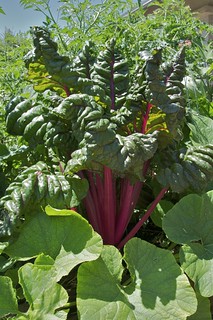A YouTube video uploaded by an experienced straw bale gardener described how he starts conditioning the straw bales in the winter (he is in northern snow country). I kicked it into high gear to dig out the Bermuda grass so I could allow more time for the straw bales to start composting before the spring planting season began.
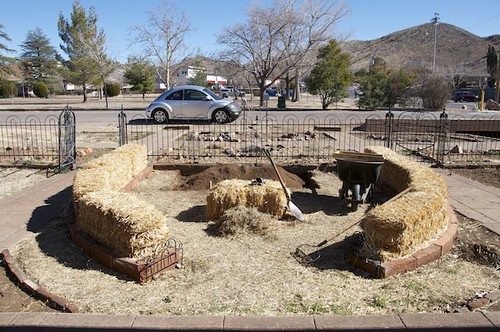 |
| 19 Jan 2012 |
The orientation of the straw bales is another consideration. It is suggested to set the bales where the straw is oriented in a vertical direction. I experimented with the straw oriented in each direction and both directions gave the same final results. I noticed that the straw bales set with the straw in a vertical direction were easier to soak compared with the bales that were set with the straw in a horizontal direction. The water had the tendency to run off the sides of the bales set with the straw in a horizontal position rather than soaking in. That was when I was watering by hand. Once I installed the soaker hose system and the straw bales were well into composting mode, it really didn't make much of a difference.
I set the straw bales roughly 3 inches into the dirt for stabilization. The bricks were placed more for decoration at this point but they still provided additional stabilization for the tall straw bales. Their main purpose is to hold the remaining composted straw bales at the end of the season.
I tried an experiment with three straw bales in April, just before the 2 driest months of the year. I worried that it would be difficult to maintain enough moisture for the conditioning period this late in the season so I set them deeper (half way down) into the soil. That worked as well as setting them down 3 inches and they held enough moisture between the watering schedules to grow the plants. I noted that they composted down below the ground level within a couple of months. I added topsoil over them to bring up the soil level when it was necessary.
I was not aware until recently that our neighborhood has a burrowing animal problem. The culprit has not been identified yet but I have noticed about a month ago that it has discovered my garden. The holes look suspiciously like a mole’s handiwork but my neighbors report a ground squirrel infestation. Laying down wire screen or fencing before you set your straw bales is recommended as a preventative measure.
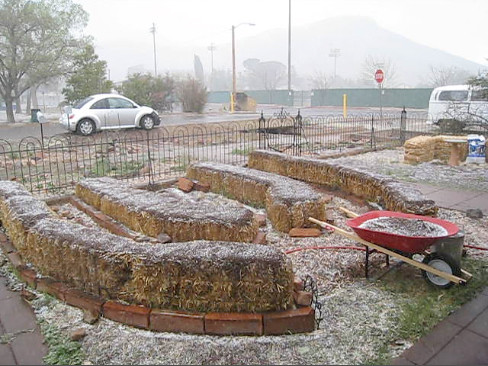 |
| 19 Mar 2012 |
I realized quickly that hand watering the seedlings became not only a chore (unclipping the covers sometimes twice a day) but the pressure was also disturbing the seeds and soil. The water spray, even at the lightest setting was washing away the little bit of soil on top and exposing the seedling’s roots. Since I noticed seeds from the inside ring of straw bales were sprouting in the outer ring and seedlings growing between the bricks and bales, I could only imagine that the water pressure must have caused the seeds to bounce off one straw bale onto another and rooted. My tip for you is to set up your automatic watering system before or immediately after you sow your seeds. I used a small diameter soaker hose system and set the schedule for twice a day. The key to success is to never let the straw bales dry out. I also recommend buying an extra straw bale. I used loose straw to fill in the gaps between the bales and to spread around the base of the plants as needed.
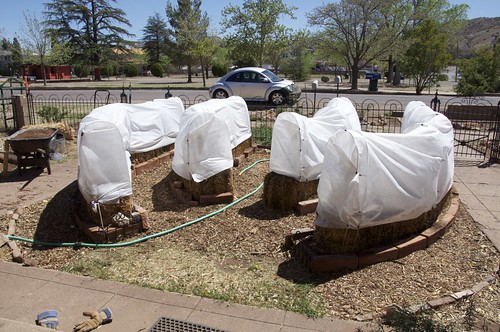 |
| 11 Apr 2012 |
I had my first minor setback in early May. I made the mistake of uncovering the straw bales for some anticipated rain but we received a freak hailstorm instead. The young plants were battle worn but all of them fully recovered to my great surprise.
 |
| 9 May 2012 |
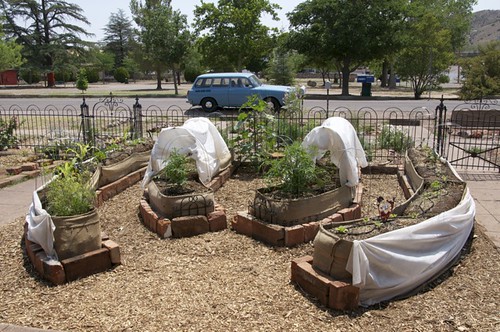 |
| 31 May 2012 |
 |
| 1 Jul 2012 |
To plant a starter in the bales, create a hole using a spade. Sometimes a pruner is necessary if the straw is tough and you need to transfer a plant from a quart size pot. I pushed the straw down using my fist until I felt resistance. I made a hole at least 1" larger in diameter and 2" deeper than the pot that the starter plant came in. I poured 2" of enriched soil in the hole, nestled the plant in, added the soil to fill in the extra space and spread the straw I removed from the hole over the base. I used the soil from my garden mixed with organic compost. As a side note, I discovered later that this is not recommended as you run the risk of adding harmful viruses or plant-parasite nematodes from your garden’s soil. I didn’t have any problems that I’m aware of so use your best judgment.
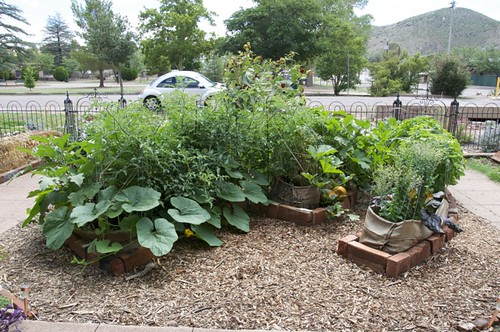 |
| 29 Jul 2012 |
 |
| 3 Aug 2012 |
The challenges with nurturing the kitchen garden had more to do with the factors any gardener would face and were unrelated to the straw bale gardening method. The straw bales provided the necessary nutrients and then some. Although a variety of garden pests arrived; vine borers, squash bugs, flea beetles, locusts, hornworms and leaf-footed bugs, the plants held up against the onslaught remarkably well. I attribute this to the fact that the plants were strong and healthy, living in the rich environment that the composting straw bales provided. The swiss chard reached science fiction proportions.
I feel a sense of validation when several visitors expressed the desire to try straw bale gardening after seeing my results. In fact, my partner was told, "You must have started something", from the feed store employee who remembered us buying straw bales for gardening earlier in the year because they were currently sold out of straw bales with the demand coming from other gardeners in the area.
 |
| 11 Sep 2012 |
Links for the straw bale gardener:
No Dig Vegetable Garden
Straw Bale Gardening: Start to Finish (YouTube Video)
Daves Garden: Strawbale Gardening Forum (subscriber membership fee)
